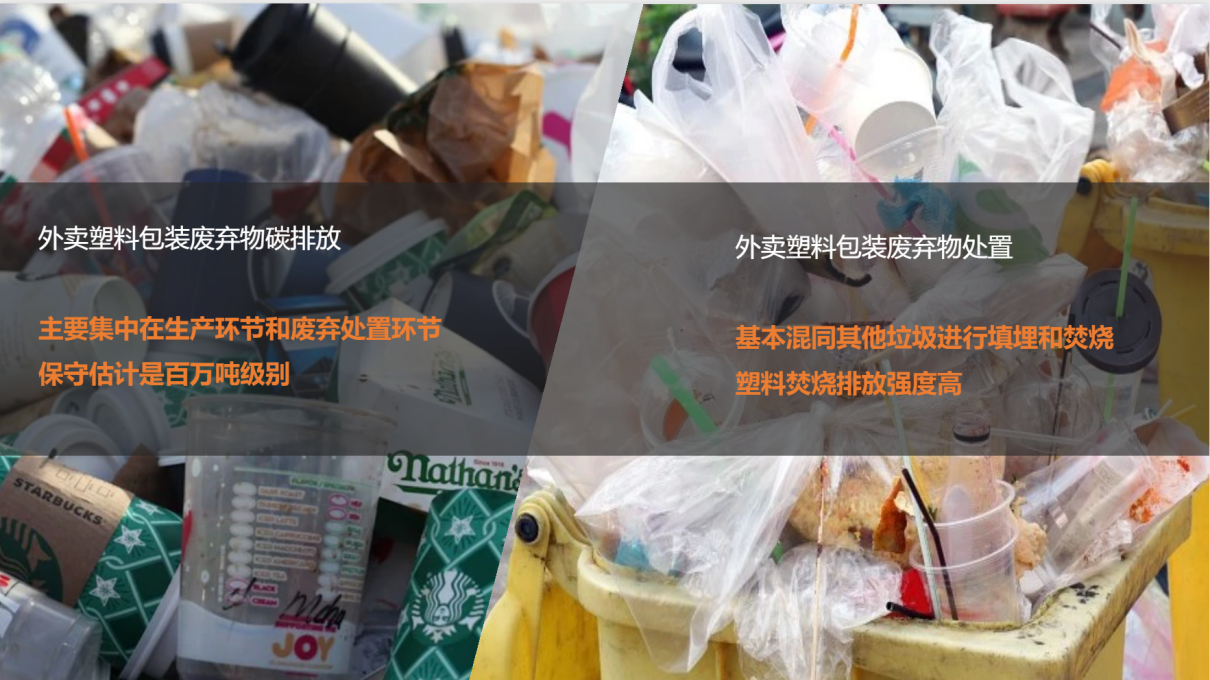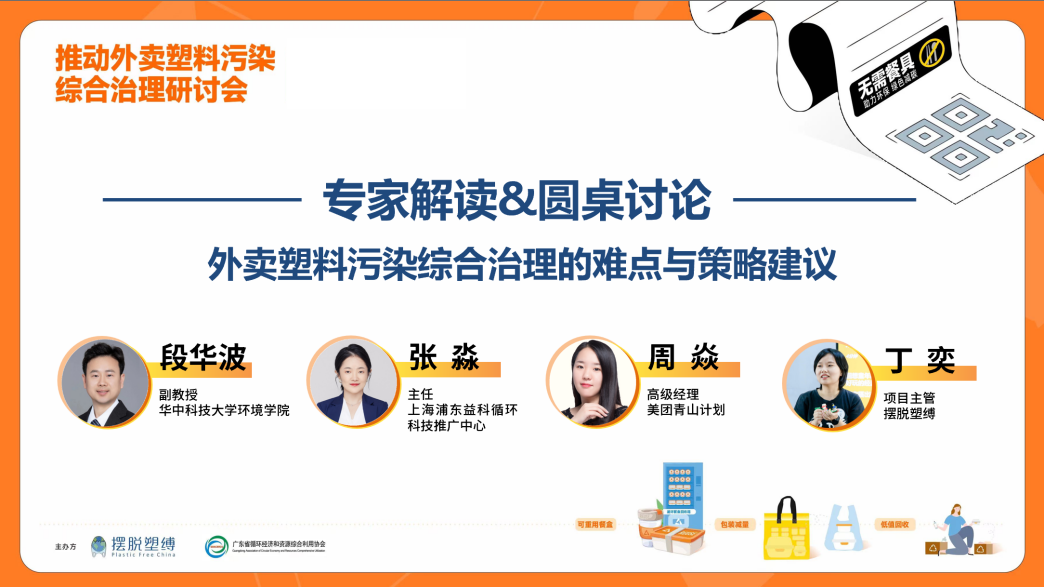Expert Focus: How to control plastic packaging pollution due to the popularity of takeaway?
The takeaway industry is closely related to our lives, but takeaway plastic packaging produces a large amount of disposable plastic pollution, which not only produces millions of tons of carbon emissions every year, but also consumes hundreds of millions of yuan in end-of-line waste treatment costs, which poses a challenge to the achievement of the national "double carbon" goal and the end-of-line waste treatment capacity.
In response to the problem of pollution control of takeaway plastic packaging, recently, environmental protection agencies have joined hands with the Guangdong Association of Circular Economy and Comprehensive Utilization of Resources, and invited environmental experts, research scholars, and representatives of takeaway platforms to participate in the online discussion on "Promoting the Comprehensive Treatment of Takeaway Plastic Pollution" to jointly promote the further control of takeaway plastic pollution.
The rapid development of the food delivery industry has brought plastic pollution, and it is important to promote source reduction and recycling
China's food delivery industry has maintained strong growth in the past five years, with a compound annual growth rate of 35%. The growth of takeaway business also means that the use of takeaway packaging increases. Research data shows that the total amount of plastic packaging waste in China is 460,000 tons to 1.68 million tons, and it is growing rapidly with the development of the takeaway market.
Luo Tiansheng, deputy director of the Guangdong Association of Circular Economy and Comprehensive Utilization of Resources, said: "China's food delivery market is growing rapidly, accounting for nearly half of the global food delivery market turnover. Ordering takeout has become a consumer lifepracticePart of habit. It can be expected that China's takeaway market still has huge growth potential in the future. ”
While the development of the food delivery industry brings great economic potential, it is also accompanied by corresponding environmental pressures. Duan Huabo, an associate professor at the School of Environment at Central China Normal University, said: "Although there is no essential difference between takeaway packaging and traditional packaging, it is closely related to our lives and the number is increasing, which has aroused extensive discussions, and we still need to pay attention to its continuous growth trend. Because from the perspective of environmental impact, there is a certain amount of emissions in the production and processing stages of takeaway packaging, especially after disposal, which may bring greater environmental pressure. ”
In order to deal with the problem of plastic pollution in takeaways, several mainstream takeaway platforms in China attach great importance to corporate social responsibility and have made a lot of efforts and attempts in the past few years.
In the internationally accepted "3R principles of waste management", the first place in the order is "source reduction", which Ding Yi, the director of the plastic reduction project of getting rid of plastic shackles, likens it to "turning off the faucet". Ding Yi said that the implementation of "no tableware" has become an important starting point for the reduction of plastic waste in the takeaway industry, which can help consumers develop their own tablewarepracticehabit, thus laying the necessary foundation for the subsequent use of reusable lunch boxes or the reduction of single-use products.
However, according to the survey data on the implementation of "no tableware" in the takeaway industry in 2023, only 17.4% of consumers set "no tableware" as the default option for takeaway, and 65.7% of consumers have encountered the situation that they still receive tableware after choosing to do not need tableware, which shows that there is still room for improvement in the proportion of "no tableware" orders. Getting rid of plastic shackles said that he looks forward to continuing to cooperate with takeaway platforms, catering businesses and consumers to promote the implementation of "no tableware" on takeaway platforms.
In addition to promoting the implementation of "no utensils required", Meituan's food delivery platform is also striving to explore plastic reduction and recycling solutions at the source from other angles. Launched in 2017, Zhou Yan, Senior Manager of Meituan Tsingshan Project, said: "Since 2018, Meituan has explored some aspects of recycling, from initially using office buildings as a pilot, to taking the lead in Xiamen and Shanghai in 2021 to achieve large-scale lunch box recycling in Xiamen and Shanghai, and then expanding to Shenzhen, Beijing and other places. Meituan has teamed up with the government and back-end recycling companies to build a city-level recycling system. At present, 14 provinces and 15 cities have carried out large-scale recycling, and more than 17,000 tons of plastic lunch boxes have been recycled. ”
Alternative materials are controversial, and degradable plastics and non-woven fabrics are not the most preferred choices for plastic reduction
In addition to source reduction, many businesses have also turned their thinking to material "substitution".
Biodegradable plastics, which are widely used in takeaway plastic packaging, are being used nationwide as "environmentally friendly materials". However, the "Environmental Impact Assessment and Policy Support Research Project Report on Degradable Plastics" jointly released by Tsinghua University and Sinopec in 2022 revealed that 96.77% of degradable plastics go to landfill or incineration, and the proportion that can actually enter industrial compost and anaerobic fermentation treatment is less than 0.01%.
According to Zhang Miao, director of Shanghai Pudong Yike Recycling Technology Promotion Center, the use of degradable plastics to reduce carbon emissions in the field of takeaway is not obvious. "If it's completely bio-based, it may play a role as a substitute for chemical raw materials and have certain advantages in terms of carbon emissions, but if it's still a single-use product, then it usually ends up in an environment like incineration and landfills, which is not much different from ordinary materials, but it may be more expensive," she explained. ”

Similar to biodegradable plastics, non-woven bags are also widely used by takeaway businesses as alternative "eco-friendly" materials. However, "non-woven fabrics" are a kind of weaving techniques, and the main materials of many non-woven fabrics are still plastic. According to Zhang Miao's observation, many non-woven bags in the takeaway industry are becoming thicker and heavier, and some packaging is used for thermal insulation, and the plastic content is increasing instead of decreasing. From this point of view, the use and promotion of some non-woven bags is contrary to the goal of plastic reduction.
Ding Yi said frankly: "From the perspective of plastic reduction, reducing any form of disposable packaging from the source is an important principle of plastic reduction. Disposable packaging, including non-woven packaging, can be used without use, and can be reduced if it can be reduced. ”
Zhou Yan also observed the significant increase in the number of non-woven bags used by merchants, and she added practical cases from the perspective of takeaway platforms, "Tsingshan Project has encouraged incentive activities for the recycling of non-woven bags through cooperation with merchants, and expects that non-woven bags can be applied to more reuse scenarios." ”
7 times can offset the environmental impact, why is it still difficult to promote recycled lunch boxes?
In terms of plastic reduction in takeaway packaging, the promotion and use of recycled lunch boxes is also an effective measure. According to the "Research Report on the Economic and Environmental Benefits of Takeaway Circular Lunch Boxes - Based on the Case of Shunde Campus of Southern Medical University" released by Getting rid of Plastic Constraints in 2022 and Shenzhen University and Beijing Peisi Green Technology Development Center, it shows that every 7 cycles of Shuangti Recycling Lunch Box during operation can offset the environmental impact of disposable lunch boxes in five types of indicators. As of May 2022, the average number of recycling times of lunch boxes on campus is 63 times, which has effectively reduced the burden of garbage disposal on campus.
However, the circulating lunch box is still in its infancy in mainland China, and most of them appear in specific closed scenes, and it is still difficult to implement and promote, and compared with North America, Europe and other regions, the development of circulating heavy lunch boxes in China is still in a significant lagging stage.
As the largest food delivery platform company in China, Meituan has long experienced the difficulty of implementing the recycled lunch box model. Zhou Yan said: "First of all, recycled lunch boxes need to solve a series of problems such as recycling, disinfection and redistribution. Due to the large variety of Chinese food and its non-standard packaging, it is still challenging to solve the problem of lunch box recycling under the premise of non-standard mode and huge total volume. ”
In the face of practical difficulties, Duan Huabo, an associate professor at the School of Environment of Huazhong University of Science and Technology, still has an optimistic and resolute attitude: "Recycling lunch boxes must still be promoted, which is an important measure to reduce waste, especially plastic." ”
As for how to do it, Duan Huabo proposed two future directions - first, it can be piloted in closed and high-density scenarios and key cities such as campuses and communities;
"When both large and small cycles are established and perfected, it will be possible to achieve a scenario where consumers order at home and hand over the packaging to a dedicated third-party recycler or recycling system when they are finished. The system will not only be limited to recycling lunch boxes, but also recycling most consumer product packaging for fresh fruits and e-commerce platforms, and uniformly redistributing the packaging into the market, so as to reduce and share costs. Duan Huabo said.
The promotion of the circular model of catering takeaway still needs comprehensive policy guidance
How to make the circulation mode of catering takeaway break through the scene restrictions as soon as possible, move towards a broader space, and win a larger market share?

Roundtable guests at the seminar.
Zhang Miao believes that "there should be more policy support from the perspective of recycling. Zhou Yan also put forward a similar appeal from the perspective of enterprises, "In the formulation of policies, we can do some support for industries and enterprises engaged in low-value recyclables, including improving the recycling system of low-value recyclables." At the same time, we will strengthen publicity and advocacy for ordinary residents, and guide more residents to participate in garbage sorting and recycling. ”
Ding Yi said: "The establishment of the recycling system is very important, and we also look forward to policies that can help us do better in source reduction, in addition to strengthening the supervision of the implementation of the takeaway industry's 'no tableware', we can also refer to China's successful experience in express plastic pollution control, such as taking source reduction as the basic principle, and at the same time improve relevant policies, establish supporting measures, and cooperate with specific goals, clarify the leading authorities, implement specific measures to pilot, and lead the industry to implement policy objectives." ”
Luo Dan, moderator and chairman of Chengdu Roots & Shoots Environmental and Cultural Exchange Center, concluded: "This symposium brings together representatives from enterprises, research institutions, social organizations and environmental protection organizations, and believes that it can provide an effective reference for tackling the challenges of plastic pollution in takeaway and formulating more effective solutions to plastic pollution. It also lays a good foundation for all relevant parties to strengthen exchanges and cooperation with each other in the future and promote the improvement and implementation of comprehensive control of plastic pollution in takeaways. ”







